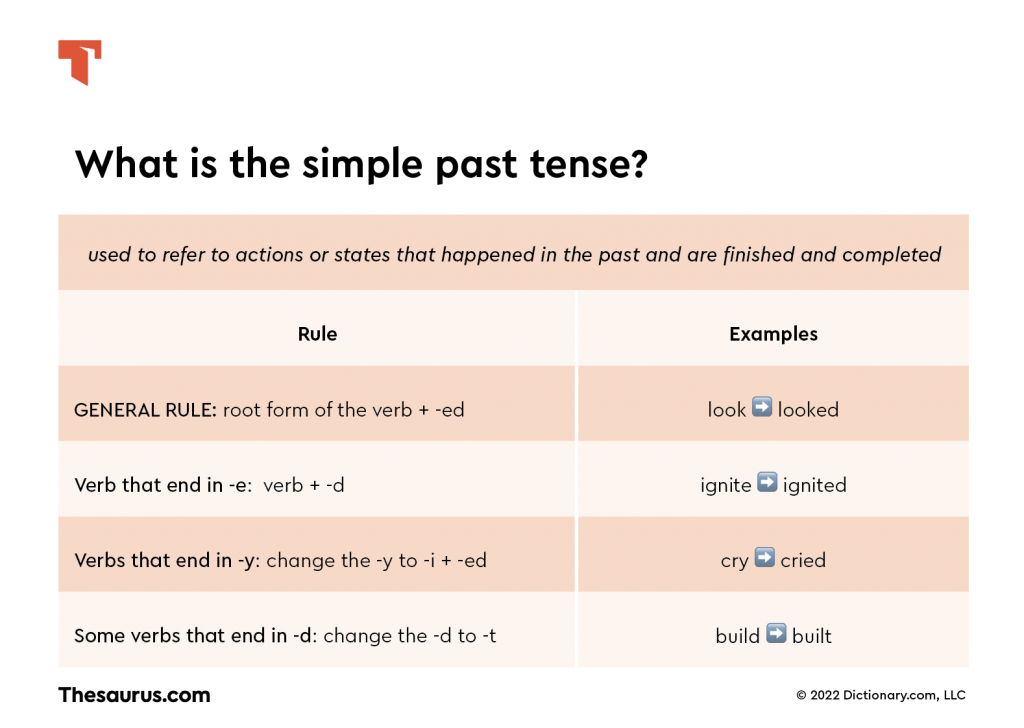Yesterday, I washed my car. Last week, I visited my friends. Last year, I broke my arm. Ten years ago, I studied Korean. All of these things happened in the past, but these sentences also all have one other thing in common: they use verbs in the simple past tense. For now, let’s focus on the present and learn more about this particular verb tense.

What is simple past tense?
When speaking or writing, we use verbs to express actions, states, or relationships. In English, we use 12 major verb tenses. Each of theses tenses, generally speaking, identifies when something happened in time. In the case of simple past tense, we will need to turn back the clock and look at things we did in days past.
When do you use simple past tense?
We use the simple past tense to refer to actions or states that happened in the past and are finished and completed. For example, the sentence Samantha played baseball says that Samantha started and finished playing baseball sometime in the past. She isn’t playing baseball right now. As another example, the sentence My dog smelled terrible says that your dog had a terrible smell in the past, but she doesn’t smell terrible now because you either aren’t sniffing her or you gave her a bath and now she smells great.
Remember, the simple past tense only refers to events that completely finished in the past. If a sentence refers to an event that continues into the present or was interrupted, it doesn’t use the simple past tense. For example, the sentence I was cleaning my house refers to an action that began in the past but didn’t finish in the past. This sentence does not use the simple past, but instead uses a verb tense known as the past continuous tense.
How to form simple past tense
For most verbs, the method to form the simple past tense is relatively simple. (See what we did there?) Typically, you would form the past tense as follows:
- Take the root form of the verb (the one you will find in our amazing dictionary) and add –ed to the end.
- If the verb ends in -e, you would just add a -d. For example, the simple past tense of look is looked, and the simple past tense of ignite is ignited.
- For verbs that end in -y, the -y usually changes to an –i if it follows a consonant. For example, the verb cry becomes cried but the verb play becomes played.
- One notable exception to this general rule is the group of verbs that use the –t variant, where they end in a -t instead of a -d. The verbs build (which becomes built), sleep (which becomes slept), and send (which sent) are just three examples of verbs that use the –t variant.
When we add subjects to the mix, things stay relatively simple. The simple past tense of the verb remains the same regardless of if the subject is singular or plural or what person (first, second, or third) it is:
- I jumped.
- We jumped.
- You jumped.
- The lion jumped.
- The lions jumped.
Things remain the same for both transitive and intransitive verbs:
- I cleaned.
- I cleaned my room.
- Tim cooked.
- Tim cooked bacon.
However, the simple past tense gets a lot trickier when we run into irregular verbs. There are many irregular verbs in English (many of which have endured from the original days of the English language, which were once conjugated in much more complex ways) that don’t follow the typical rules of simple past tense.
Unfortunately, there is no general rule for how to form the simple past tense in irregular verbs. You will simply need to learn these verb forms (though there are some patterns) or use a dictionary to figure out what the simple past tense is.
Here are just a few examples of the simple past tense of some irregular verbs (present form → irregular past):
- fly → flew
- buy → bought
- think → thought
- know → knew
- choose → chose
- eat → ate
- drive → drove
- swim → swam
- run → ran
- go → went
- drink → drank
- get → got
- stink → stank/stunk
- catch → caught
A very commonly used irregular verb is the verb be. Unlike all other verbs, the verb be does change in the simple past tense depending on if the subject is singular or plural. For singular subjects, the simple past tense of be is was. For plural subjects (and singular you), the simple past tense is were.
- I was an artist.
- She was rich.
- We were artists.
- They were rich.
How to make simple past tense negative
Almost all verbs follow the rules when it comes to making the simple past tense negative. In order to make the simple past tense negative, you use the phrase did not before the root form of the verb. The contraction didn’t can also be used. Here are examples of the simple past tense used in the negative:
- I did not eat the pizza.
- He didn’t go to the bank.
- We didn’t watch the movie.
- My friends did not lie to me.
The most common exception to this rule is our old pal be. To make be negative in the simple past tense, we use either was not or were not depending on if the subject is singular or plural. The contractions wasn’t or weren’t can also be used.
- I was not a bad kid.
- She wasn’t tired.
- We were not alone.
- My parents weren’t amused.
A less common exception has to do with helping verbs. Although these verbs aren’t often used alone, it is possible to do so. To make the simple past tense negative, we follow the simple past tense form of the verb with the word not. Contractions can also be used.
- Ashley solved the math problem, but I could not.
- She passed the math test, but I didn’t.
A simple trick for perfect grammar
Improve your writing with Thesaurus.com’s Grammar Coach™, which catches grammar and spelling errors and provides Thesaurus-powered synonym suggestions. Using machine learning, this tool can spot the difference between the different verb tenses, making sure you’re using them correctly—and much more! Whether you’re writing in the past, present, or future, perfect grammar has never been easier.















